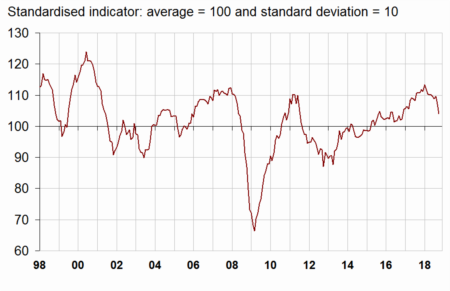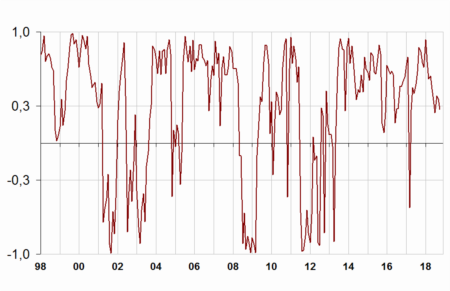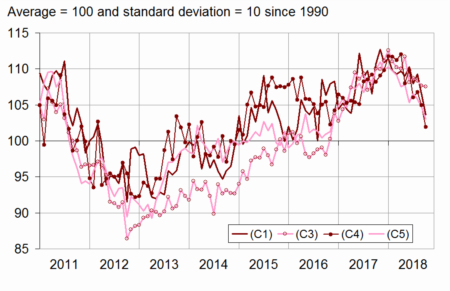 24 October 2018
2018- n° 273In October 2018, the business climate has further weakened in the manufacturing industry Monthly business survey (goods-producing industries) - October 2018
24 October 2018
2018- n° 273In October 2018, the business climate has further weakened in the manufacturing industry Monthly business survey (goods-producing industries) - October 2018
According to the business managers surveyed in October 2018, the business climate in industry has further deteriorated compared to the previous month. The composite indicator has decreased again by three points. At 104, it remains however well above its long-term average (100).
- Significant drop in the balance of manufacturers' opinion on their past activity
- In the agrofood industry, the business climate has further deteriorated
- The business climate remains stable in the manufacture of machinery and equipment goods
- The business climate in the manufacture of transport equipment continues to deteriorate
- The business climate continues to decline in “other manufacturing industries”
According to the business managers surveyed in October 2018, the business climate in industry has further deteriorated compared to the previous month. The composite indicator has decreased again by three points. At 104, it remains however well above its long-term average (100).
graphiqueGraph 1 – Business climate in industry - Composite indicator

The turning-point indicator remains in the zone indicating a favourable economic outlook.
graphiqueGraph 2 – Turning-point indicator

- How to read it: close to 1 (resp. -1), the indicator points to a favourable short-term economic situation (resp. unfavourable). The uncertainty area is between −0.3 and +0.3.
Significant drop in the balance of manufacturers' opinion on their past activity
The balance of industrialists' opinion on their past activity has dropped again, more significantly in October than in September. That on their personal production expectations is virtually stable, after having sharply fallen in September. Both balances remain above their long-term average.
Optimism among manufacturers about the general production prospects for the sector persists. The corresponding balance, virtually stable, stands well above its average. However, industrialists report fewer orders: the balance of opinion on overall order books has dropped significantly, that on export order books has fallen more moderately. Both remain above their long-term average.
More industrialists than in September consider that their finished-goods inventories are above normal. The corresponding balance has slightly increased while remaining below its long-term mean.
As regards employment, the balances of opinion on past and expected workforce size have slightly decreased. They remain however well above their long-term average.
tableauTable 1 – Industrialists' opinion on manufacturing activity
| Manufacturing industry | Ave.* | July 18 | Aug. 18 | Sept. 18 | Oct. 18 |
|---|---|---|---|---|---|
| Composite indicator | 100 | 109 | 110 | 107 | 104 |
| Past activity | 5 | 10 | 18 | 15 | 6 |
| Finished-goods inventory | 13 | 10 | 11 | 7 | 9 |
| Overall order books | –18 | –4 | –4 | –5 | –12 |
| Export order books | –14 | –2 | –4 | –4 | –6 |
| Past workforce size | –10 | 3 | 0 | 2 | 0 |
| Expected workforce size | –12 | 1 | 2 | 2 | 0 |
| Personal production expectations | 5 | 23 | 20 | 9 | 10 |
| General production expectations | –8 | 10 | 11 | 8 | 7 |
- * Long-term average since 1976.
- Source: INSEE - Monthly business tendency survey in industry
In the agrofood industry, the business climate has further deteriorated
In the manufacture of food products and beverages, the business climate indicator has declined again losing three points in October. At 104, it remains above its long-term average (100). This fall mainly comes from the decrease in the balance on overall order books.
The business climate remains stable in the manufacture of machinery and equipment goods
In the overall manufacture of machinery and equipment goods, the business climate is stable, at 108, well above its long-term average (100). The increase in the balance on personal production expectations is offset by the decrease in the balances on past activity and on overall order books.
The business climate has further improved in the computer, electronic and optical product industry. By contrast, it is less favourable than in September in the electrical equipment industry. It is stable and close to its average in machinery and equipment.
The business climate in the manufacture of transport equipment continues to deteriorate
In the manufacture of transport equipment, the business climate has decreased by three extra points. At 102, it has come closer to its long-term average (100). This deterioration mainly comes from the decline in the balance on overall order books, in particular in the motor industry.
The business climate indicator has sharply declined in the manufacture of motor vehicles, trailers and semi-trailers: it has fallen below its long term average and has reached its lowest level since 2014. It is stable in the manufacture of other transport equipment.
The business climate continues to decline in “other manufacturing industries”
In overall “other manufacturing”, the business climate is once again less favourable than in the previous month the corresponding indicator has gone down by 2 points, to 103. This new dip mainly comes from the decrease in the balances on overall and export order books.
By subsector, the business climate indicator has fallen in in wood-paper. To a lesser extent, it has decreased also in rubber and plastic products, in chemicals, in basic metals and in clothing-textiles. However, it has significantly picked up in the “other manufacturing industries”.
graphiqueGraph 3 – Business climates in a sector-based approach

- Legend: (C1): Manufacture of food products and beverages - (C3): Machinery and equipment goods - (C4): Manufacture of transport equipment - (C5): Other manufacturing
tableauTable 2 – Business climates in a sector-based approach
| NA* : (A17) et [A38 et A64] | Weights** (%) | Aug. 18 | Sept. 18 | Oct. 18 |
|---|---|---|---|---|
| (C1) Man. of food products and beverages | 21 | 109 | 107 | 104 |
| (C3) Machinery and equipment goods | 11 | 108 | 108 | 108 |
| [CI] Computer, electronic and optical products | 3 | 107 | 112 | 113 |
| [CJ] Electrical equipment | 3 | 114 | 113 | 111 |
| [CK] Machinery and equipment | 5 | 103 | 101 | 101 |
| (C4) Man. of transport equipment | 17 | 107 | 105 | 102 |
| [CL1] Motor vehicles, trailers and semi-trailers | 8 | 108 | 103 | 97 |
| [CL2] Other transport equipment | 9 | 104 | 105 | 105 |
| (C5) Other manufacturing | 46 | 106 | 105 | 103 |
| [CB] Textiles, clothing industries, leather and footwear industry | 2 | 113 | 114 | 113 |
| [CC] Wood, paper, printing | 5 | 108 | 108 | 99 |
| [CE] Chemicals and chemical products | 9 | 104 | 104 | 101 |
| [CG] Rubber and plastic products | 7 | 109 | 107 | 105 |
| [CH] Basic metals and fabricated metal products | 11 | 104 | 103 | 101 |
| [CM] Other manufacturing industries | 9 | 103 | 101 | 105 |
- * NA: aggregated classification, based on the French classification of activities NAF rév.2.
- ** Weights used to aggregate sub-sector's balances of opinion.
- Source: INSEE - Monthly business tendency survey in industry
Documentation
Methodology (pdf,133 Ko)
Pour en savoir plus
Time series : Industry - Activity and demand




